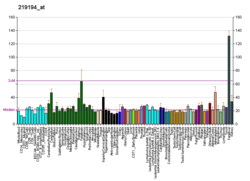SEMA4G
Semaphorin-4G is a protein that in humans is encoded by the SEMA4G gene.[5]
Semaphorins are a large family of conserved secreted and membrane associated proteins which possess a semaphoring (Sema) domain and a PSI domain (found in plexins, semaphorins and integrins) in the N-terminal extracellular portion. Based on sequence and structural similarities, semaphorins are put into eight classes: invertebrates contain classes 1 and 2, viruses have class V, and vertebrates contain classes 3-7. Semaphorins serve as axon guidance ligands via multimeric receptor complexes, some (if not all) containing plexin proteins. This gene encodes a class 4 semaphorin. This gene and the gene for mitochondrial ribosomal protein L43 overlap at map location 10q24.31 and are transcribed in opposite directions.[5]
References
- GRCh38: Ensembl release 89: ENSG00000095539 - Ensembl, May 2017
- GRCm38: Ensembl release 89: ENSMUSG00000025207 - Ensembl, May 2017
- "Human PubMed Reference:". National Center for Biotechnology Information, U.S. National Library of Medicine.
- "Mouse PubMed Reference:". National Center for Biotechnology Information, U.S. National Library of Medicine.
- "Entrez Gene: SEMA4G sema domain, immunoglobulin domain (Ig), transmembrane domain (TM) and short cytoplasmic domain, (semaphorin) 4G".
Further reading
- Pasterkamp RJ, Kolodkin AL (2003). "Semaphorin junction: making tracks toward neural connectivity". Curr. Opin. Neurobiol. 13 (1): 79–89. doi:10.1016/S0959-4388(03)00003-5. PMID 12593985.
- Dickson BJ (2003). "Molecular mechanisms of axon guidance". Science. 298 (5600): 1959–64. doi:10.1126/science.1072165. PMID 12471249.
- Holtmaat AJ, De Winter F, De Wit J, et al. (2002). "Semaphorins: contributors to structural stability of hippocampal networks?". Prog. Brain Res. Progress in Brain Research. 138: 17–38. doi:10.1016/S0079-6123(02)38068-3. ISBN 978-0-444-50981-9. PMID 12432760.
- Rual JF, Venkatesan K, Hao T, et al. (2005). "Towards a proteome-scale map of the human protein-protein interaction network". Nature. 437 (7062): 1173–8. doi:10.1038/nature04209. PMID 16189514.
- Gerhard DS, Wagner L, Feingold EA, et al. (2004). "The Status, Quality, and Expansion of the NIH Full-Length cDNA Project: The Mammalian Gene Collection (MGC)". Genome Res. 14 (10B): 2121–7. doi:10.1101/gr.2596504. PMC 528928. PMID 15489334.
- Deloukas P, Earthrowl ME, Grafham DV, et al. (2004). "The DNA sequence and comparative analysis of human chromosome 10". Nature. 429 (6990): 375–81. doi:10.1038/nature02462. PMID 15164054.
- Strausberg RL, Feingold EA, Grouse LH, et al. (2003). "Generation and initial analysis of more than 15,000 full-length human and mouse cDNA sequences". Proc. Natl. Acad. Sci. U.S.A. 99 (26): 16899–903. doi:10.1073/pnas.242603899. PMC 139241. PMID 12477932.
- Nagase T, Kikuno R, Nakayama M, et al. (2001). "Prediction of the coding sequences of unidentified human genes. XVIII. The complete sequences of 100 new cDNA clones from brain which code for large proteins in vitro". DNA Res. 7 (4): 273–81. doi:10.1093/dnares/7.4.271. PMID 10997877.




